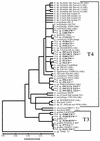18S ribosomal DNA typing and tracking of Acanthamoeba species isolates from corneal scrape specimens, contact lenses, lens cases, and home water supplies of Acanthamoeba keratitis patients in Hong Kong
- PMID: 11980931
- PMCID: PMC130944
- DOI: 10.1128/JCM.40.5.1621-1625.2002
18S ribosomal DNA typing and tracking of Acanthamoeba species isolates from corneal scrape specimens, contact lenses, lens cases, and home water supplies of Acanthamoeba keratitis patients in Hong Kong
Abstract
We examined partial 18S ribosomal DNA (Rns) sequences of Acanthamoeba isolates cultured in a study of microbial keratitis in Hong Kong. Sequence differences were sufficient to distinguish closely related strains and were used to examine links between strains obtained from corneal scrape specimens, contact lenses, lens cases, lens case solutions, and home water-supply faucets of patients with Acanthamoeba. We also looked for evidence of mixed infections. Identification of Acanthamoeba Rns genotypes was based on sequences of approximately 113 bp within the genus-specific amplicon ASA.S1. This permitted genotype identification by using nonaxenic cultures. Of 13 specimens obtained from corneal scrapes, contact lenses, lens cases, or lens case solutions, 12 were Rns genotype T4 and the remaining one was Rns genotype T3. The sequences of corneal scrape specimens of two patients also were the same as those obtained from their contact lenses or lens case specimens. A possible triple-strain infection was indicated by three different T4 sequences in cultures from one patient's lenses. Although faucet water used by patients to clean their lenses is a possible source of infections, specimens isolated from the faucets at two Acanthamoeba keratitis patients' homes differed from their corneal scrape or lens specimens. The overall results demonstrate the potential of this Rns region for tracking Acanthamoeba keratitis strains in infections and for distinguishing single-strain and closely related multiple-strain infections even when other microorganisms might be present with the cultured specimens. They also confirm the predominance of Rns genotype T4 strains in Acanthamoeba keratitis infections.
Figures


References
-
- Dyková, I., J. Lom, J. M. Schroeder-Diedrich, G. C. Booton, and T. J. Byers. 1999. Acanthamoeba strains isolated from organs of freshwater fishes. J. Parasitol. 85:1106-1113. - PubMed
-
- Gast, R. J., D. R. Ledee, P. A. Fuerst, and T. J. Byers. 1996. Subgenus systematics of Acanthamoeba: four nuclear 18S rDNA sequence types. J. Eukaryot. Microbiol. 43:498-504. - PubMed
-
- Houang, E., D. Lam, D. Fan, and D. Seal. 2001. Microbial keratitis in Hong Kong: relationship to climate, environment, and contact lens disinfection. Trans. R. Soc. Trop. Med. Hyg. 95:361-367. - PubMed
-
- Hugo, E. R., V. J. Stewart, R. J. Gast, and T. J. Byers. 1992. Purification of amoeba mtDNA using the UNSET procedure, p. D-7.1. In A. T. Soldo and J. J. Lee (ed.), Protocols in protozoology. Allen Press, Lawrence, Kans.
-
- Ledee, D. R., J. Hay, T. J. Byers, D. V. Seal, and C. M. Kirkness. 1996. Acanthamoeba griffini. Molecular characterization of a new corneal pathogen. Investig. Ophthalmol. Vis. Sci. 37:544-550. - PubMed
Publication types
MeSH terms
Substances
Associated data
- Actions
- Actions
- Actions
- Actions
- Actions
- Actions
- Actions
- Actions
- Actions
- Actions
- Actions
- Actions
- Actions
- Actions
- Actions
- Actions
- Actions
- Actions
- Actions
- Actions
- Actions
- Actions
Grants and funding
LinkOut - more resources
Full Text Sources
Medical

